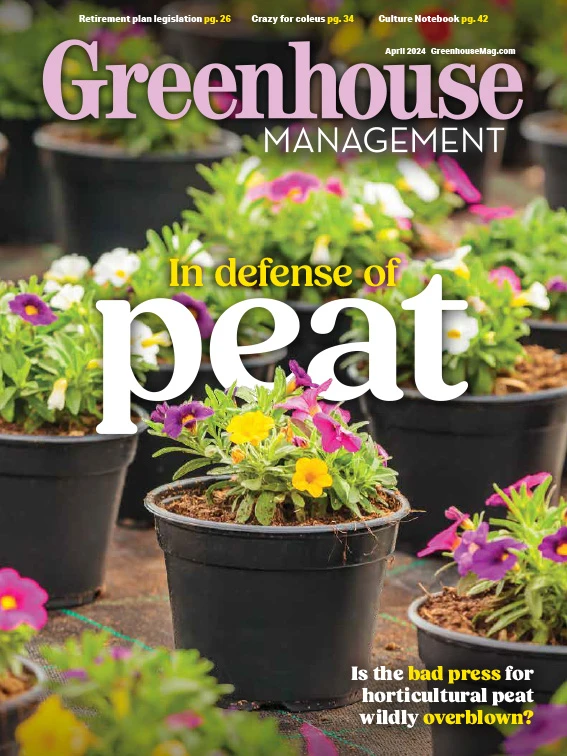
In smaller operations, efficiency can frequently be improved without the extensive use of mechanized equipment. Location of materials close to where they will be used, good workstation layout and low-cost conveyors or hand-operated carts will keep labor input to a minimum.
The following are some typical concepts and systems that are used in the industry to reduce labor related to materials handling. These are non-automated and work best for small- to medium-sized growers.
Basic concepts
A good place to start is to review some of the basic concepts that apply to plant handling. Consider the different tasks as part of a system that is related to other tasks in the growing process. Then select methods and equipment that reduce handling.
Handle plants in larger quantities. Use carrying trays that hold six to 15 pots rather than moving pots individually. Pallets, carts and conveyor systems allow more plants to be handled at one time.
Reduce walking distance. Walking is costly. As you can see from the table, carrying a flat of plants down a greenhouse aisle adds significant cost. Systems that reduce walking time usually have a short payback.
A pedometer is a good way to determine the amount of walking a person does. Multiply the number of steps by 2.2 feet for women or 2.5 feet for men to get total distance. Dividing the result by 5280 will give the distance in miles. For example, 10,000 steps/day by a woman amounts to 4.17 miles/day (10,000 steps x 2.2 ft/step ÷ 5280 ft/mile = 4.17 miles).
Standardize your operations. Limit the number of sizes and types of containers to reduce inventory that has to be carried and the time needed to make changes to equipment.
Select equipment that is easy to operate and maintain. Frequently, equipment sits idle because it is difficult to get it into proper adjustment. Provide proper training for employees that will operate this equipment. Machines with standard parts available from a local hardware store will make maintenance easier.

Carts
All sizes of greenhouse operations can benefit from carts. They increase labor efficiency by allowing one person to move more material at one time than could be carried by hand. They are also low-cost ($300-$600). The cart system can be easily expanded as the business grows.
Carts should be selected to fit into the narrow aisle in the greenhouse. A 22-inch-wide cart will handle 1020 flats. Standard length is 5 or 6 feet. Most carts have variable shelf spacing to handle different size plants and containers. Typically, a cart for moving bedding plants will hold 25 to 30 flats.
A level rolling surface is best for cart operation. In the greenhouse, the main aisle should have a hard surface. Concrete and stone dust work well. A minimum 30-inch-wide aisle down the length of the greenhouse or bay is needed. Larger diameter tires (6 or 8 inches) will make pushing the cart easier.
The same carts used for moving plants in the greenhouse can also be used for shipping. This will eliminate one or more handlings, saving money. Many larger garden centers now require plants to be handled on carts.
Monorail conveyor
This overhead conveyor system consists of tubular track suspended from the greenhouse frame. Trolley-mounted racks that carry the plants are pushed along manually. You need aisle space that is wide enough to walk and push the carts.
Curved sections of track are used to get around corners, and switches are located where a transfer is needed from one track to another. The track is easy to install with hangers from the greenhouse frame. Care should be taken that the frame is strong enough to support a load of plants.
Portable belt conveyor
Conveyors work well for handling flats or pots. This lightweight conveyor is made up of a powered section to which can be added several slave sections. The sections are connected easily and are powered by belts or gears. To change the direction of the flats or pots, an adjustable diverter bar is attached. An electric eye can be added to give a count of container flow. The drive unit, an electric motor, provides variable speed and reversible direction. The conveyor can be placed on legs or on the floor. Moving from one greenhouse or bay to another takes only a few minutes.
There are many alternatives in plant handling systems. Before selecting a system, determine how it will fit in with your facilities layout, cropping schedule, labor force situation and shipping method.

Explore the April 2024 Issue
Check out more from this issue and find your next story to read.
Latest from Greenhouse Management
- Anthura acquires Bromelia assets from Corn. Bak in Netherlands
- Top 10 stories for National Poinsettia Day
- Langendoen Mechanical hosts open house to showcase new greenhouse build
- Conor Foy joins EHR's national sales team
- Pantone announces its 2026 Color of the Year
- Syngenta granted federal registration for Trefinti nematicide/fungicide in ornamental market
- A legacy of influence
- HILA 2025 video highlights: John Gaydos of Proven Winners





